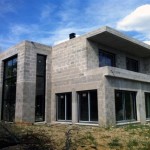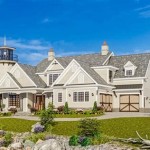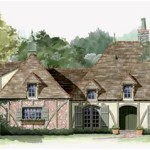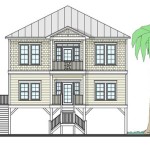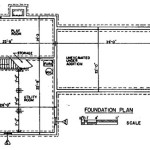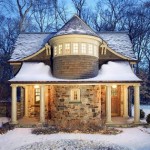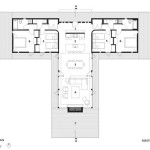House plans with a view, as the name suggests, are architectural designs that prioritize capturing captivating vistas from within the home. These plans intentionally position windows, balconies, or patios to frame stunning landscapes, city skylines, or natural wonders. An iconic example is Frank Lloyd Wright’s Fallingwater, a masterpiece that seamlessly merges architecture with the breathtaking waterfall it overlooks.
The pursuit of views in house plans is not merely an aesthetic endeavor; it has profound psychological and environmental benefits. Studies have shown that exposure to natural light and green spaces can enhance mood, reduce stress, and improve overall well-being. By incorporating ample windows and outdoor living areas, homes with views foster a sense of connection with the outdoors and promote a healthy and invigorating living environment.
In the following sections, we will delve into the captivating world of house plans with a view. We will explore different design strategies, examine the benefits they offer, and provide inspiration for homeowners seeking to create their own idyllic havens with breathtaking vistas.
When designing house plans with a view, several key considerations come into play:
- Maximize natural light
- Frame the view
- Create outdoor living spaces
- Consider privacy
- Control solar gain
- Enhance indoor-outdoor flow
- Choose the right windows
- Consider the surrounding landscape
By carefully addressing these elements, architects and homeowners can create homes that not only capture breathtaking vistas but also provide a comfortable and harmonious living experience.
Maximize natural light
Harnessing natural light is paramount in house plans with a view. Ample daylight not only illuminates the home, reducing the need for artificial lighting, but also creates a warm and inviting atmosphere. Moreover, studies have shown that exposure to natural light can boost mood, enhance cognitive function, and improve overall well-being.
- Large windows and skylights: Expansive windows and strategically placed skylights allow natural light to flood into the home, creating a bright and airy ambiance. Floor-to-ceiling windows offer unobstructed views and blur the boundaries between indoors and outdoors.
- South-facing orientation: Positioning the home’s main living areas and windows towards the south maximizes exposure to sunlight throughout the day. This orientation is particularly advantageous in the Northern Hemisphere, where sunlight is more limited.
- Reflective surfaces: Incorporating light-colored walls, ceilings, and flooring can reflect and amplify natural light, making the space feel larger and brighter. Mirrors can also be strategically placed to bounce light around the room.
- Minimize obstructions: Avoid placing bulky furniture or heavy curtains in front of windows to ensure unobstructed views and allow natural light to penetrate deep into the home.
By maximizing natural light, house plans with a view create spaces that are not only visually stunning but also conducive to a healthy and comfortable lifestyle.
Frame the view
Framing the view is a crucial aspect of house plans with a view, as it determines how the landscape is presented and experienced from within the home. Careful consideration of window placement, room layout, and interior design elements can enhance the impact of the vista and create a truly immersive visual experience.
- Window placement: The positioning of windows is paramount in framing the view. Large windows that stretch from floor to ceiling or occupy entire walls allow for unobstructed views and create a sense of being immersed in the landscape. Strategic placement of windows can capture specific focal points, such as a mountain peak, a lake, or a city skyline.
- Room layout: The layout of the rooms should complement the view. Open floor plans with minimal walls and obstructions allow for uninterrupted sightlines and maximize the impact of the vista. Arranging furniture and seating areas to face the windows ensures that occupants can fully appreciate the view from the comfort of their home.
- Interior design: Interior design elements can subtly enhance the framed view. Using a neutral color palette for walls and furnishings allows the colors of the landscape to take center stage. Incorporating natural materials like wood and stone can create a harmonious connection between indoors and outdoors.
- Window treatments: Window treatments should be carefully considered to balance privacy and unobstructed views. Sheer curtains or blinds allow for natural light to filter in while maintaining privacy, while motorized shades can be retracted to reveal the full expanse of the vista.
By thoughtfully framing the view, homeowners can create spaces that not only showcase the surrounding landscape but also evoke a sense of tranquility and connection with nature.
Create outdoor living spaces
Expanding the living space outdoors is a key aspect of house plans with a view. By seamlessly connecting the interior and exterior, homeowners can fully embrace the surrounding landscape and create opportunities for relaxation, entertainment, and al fresco dining.
- Patios and decks: Patios and decks are outdoor extensions of the home that provide a comfortable and inviting space to enjoy the view. They can be positioned to take advantage of specific vistas, such as a sunset over the water or a panoramic mountain range. By incorporating comfortable seating, outdoor fireplaces, and lighting, patios and decks become inviting destinations for both day and night.
- Balconies: Balconies are elevated outdoor spaces that offer breathtaking views from above. They can be incorporated into the design of upper-level rooms, providing a private retreat with unobstructed vistas. Balconies are perfect for enjoying morning coffee, reading a book, or simply taking in the surrounding beauty.
- Courtyards: Courtyards are enclosed outdoor spaces that create a private oasis within the home. They can be designed with lush gardens, water features, and comfortable seating areas. Courtyards provide a tranquil and secluded spot to relax, dine, or entertain guests while enjoying the view.
- Rooftop terraces: Rooftop terraces offer panoramic views that encompass the surrounding landscape. They can be transformed into stunning outdoor living spaces with seating areas, gardens, and even plunge pools. Rooftop terraces provide a unique and elevated perspective, making them ideal for entertaining or simply soaking in the beauty of the surroundings.
By creating outdoor living spaces that seamlessly connect with the interior, house plans with a view allow homeowners to maximize their enjoyment of the surrounding landscape and create a truly immersive living experience.
Consider privacy
Preserving privacy is an important consideration in house plans with a view. While expansive windows and outdoor living spaces offer stunning vistas, it is crucial to balance the desire for views with the need for seclusion and protection from prying eyes.
- Window placement: Strategic placement of windows is essential for maintaining privacy. Avoid placing large windows in areas where they may be overlooked by neighbors or passersby. Consider using frosted or tinted glass for windows in bathrooms or other private areas.
- Landscaping: Landscaping can be used to create natural privacy barriers. Planting tall hedges, trees, or shrubs around the perimeter of the property can block unwanted views and create a sense of seclusion. Careful placement of outdoor furniture and pergolas can also provide privacy while still allowing for the enjoyment of the view.
- Fencing and walls: In some cases, fencing or walls may be necessary to ensure privacy. However, these structures should be designed to complement the overall aesthetic of the home and surrounding landscape. Natural materials such as wood or stone can blend seamlessly with the environment, while modern materials like metal or glass can provide a more contemporary look.
- Window treatments: Window treatments offer a flexible solution for controlling privacy. Curtains, blinds, and shades can be adjusted to allow for natural light and views while maintaining privacy when desired. Motorized window treatments can be programmed to open and close automatically, providing convenience and enhanced privacy.
By carefully considering privacy concerns and implementing thoughtful design strategies, homeowners can create house plans with a view that offer both breathtaking vistas and a sense of seclusion and tranquility.
Control solar gain
Controlling solar gain is crucial in house plans with a view, as excessive heat and glare can compromise comfort and energy efficiency. Thoughtful design strategies can minimize solar heat gain while preserving the desired views.
- Window orientation: The orientation of windows has a significant impact on solar heat gain. South-facing windows receive the most direct sunlight, while north-facing windows receive the least. In hot climates, it is advisable to minimize south-facing windows and opt for north-facing windows to reduce solar heat gain.
- Window size and placement: The size and placement of windows should be carefully considered. Large windows allow more light and heat to enter the home, while smaller windows can help reduce solar gain. Strategic placement of windows can minimize heat gain by avoiding direct sunlight at peak hours.
- Overhangs and awnings: Overhangs and awnings are architectural features that extend beyond the roofline or window frames to shade the windows from direct sunlight. They can be designed to allow natural light to enter while blocking excessive heat and glare.
- Glazing: The type of glazing used in windows can also affect solar heat gain. Low-E (low-emissivity) glass has a special coating that reflects heat away from the home, reducing solar gain and improving energy efficiency.
By implementing these strategies, homeowners can create house plans with a view that maximize natural light and stunning vistas while minimizing solar heat gain and ensuring a comfortable indoor environment.
Enhance indoor-outdoor flow
Creating a seamless flow between indoor and outdoor spaces is essential in house plans with a view. By blurring the boundaries between the interior and exterior, homeowners can maximize their enjoyment of the surrounding landscape and create a more spacious and inviting living environment.
- Open floor plans: Open floor plans eliminate walls and partitions between living areas, creating a continuous space that flows seamlessly from the interior to the outdoors. Large windows and sliding glass doors connect the living room, dining room, and kitchen to outdoor patios, decks, or courtyards, allowing for easy movement and interaction between the two.
- Bi-fold and sliding doors: Bi-fold and sliding doors provide a wide opening between indoor and outdoor spaces. When opened, these doors create a panoramic view and extend the living area into the outdoors. They are particularly effective for connecting indoor dining areas to outdoor patios or decks, allowing for seamless indoor-outdoor entertaining.
- Outdoor rooms: Outdoor rooms are defined spaces within the landscape that are designed to function as extensions of the home. They can include outdoor kitchens, dining areas, and living rooms, complete with comfortable seating, lighting, and even fireplaces. By creating designated outdoor rooms, homeowners can enjoy the outdoors in comfort and style.
- Multi-level decks and patios: Multi-level decks and patios create a dynamic and visually appealing transition between indoor and outdoor spaces. They can be designed to follow the contours of the land, offering different vantage points and creating a sense of depth and dimension. Stairs or ramps connect the different levels, providing easy access and encouraging exploration of the surrounding landscape.
By enhancing indoor-outdoor flow, house plans with a view create a harmonious connection between the built environment and the natural surroundings, offering homeowners an immersive and invigorating living experience.
Choose the right windows
Selecting the right windows is crucial in house plans with a view, as they play a pivotal role in framing the vista, controlling natural light, and ensuring privacy. Here are key factors to consider when choosing windows for your home with a view:
- Window size and shape: The size and shape of the windows can significantly impact the view. Large windows offer more expansive views, while smaller windows can frame specific focal points in the landscape. Consider the proportions of the room and the desired impact of the view when determining the appropriate window size and shape.
- Window placement: The placement of windows is equally important. Position windows to capture the most stunning views, whether it’s a panoramic mountain range, a sparkling lake, or a vibrant city skyline. Avoid placing windows too high or too low, as this can compromise the view and natural light.
- Window type: There are various types of windows to choose from, each with its own advantages. Floor-to-ceiling windows provide unobstructed views and create a sense of immersion in the landscape. Casement windows offer wide openings and excellent ventilation. Awning windows are ideal for providing shade and privacy while still allowing natural light to enter.
- Glazing: The type of glazing used in the windows can affect the view, energy efficiency, and privacy. Low-E (low-emissivity) glass has a special coating that reflects heat away from the home, reducing solar heat gain and improving energy efficiency. Tinted glass can reduce glare and provide additional privacy.
By carefully considering these factors, homeowners can select the right windows that not only enhance the view but also complement the overall design and functionality of their house plans with a view.
Consider the surrounding landscape
When designing house plans with a view, careful consideration should be given to the surrounding landscape to ensure that the home complements its natural setting and maximizes the enjoyment of the vista. Here are key factors to consider:
Site orientation: The orientation of the home on the building site can significantly impact the view and the overall design. Position the home to take advantage of the best views, whether it’s a breathtaking mountain panorama, a sparkling lake, or a vibrant city skyline. Consider the sun’s path and prevailing winds to optimize natural light and minimize solar heat gain.
Natural features: The existing natural features on the property can greatly enhance the view and provide opportunities for integration with the landscape. Preserve and incorporate mature trees, rock formations, and water bodies into the design. Frame windows to capture specific focal points, such as a majestic oak tree or a cascading waterfall.
Vegetation: The surrounding vegetation can play a crucial role in framing the view and creating a sense of privacy. Plant trees and shrubs strategically to enhance the view, block unwanted sights, and attract wildlife. Consider the seasonal changes in vegetation and choose plants that provide year-round interest.
Outdoor living spaces: Outdoor living spaces, such as patios, decks, and balconies, should be carefully positioned to maximize the view and create a seamless connection between the interior and exterior. Orient these spaces towards the most desirable views and incorporate comfortable seating, lighting, and amenities to encourage outdoor enjoyment.
By thoughtfully considering the surrounding landscape, homeowners can create house plans with a view that not only capture the beauty of nature but also enhance the overall living experience and create a harmonious relationship between the built environment and its natural setting.










Related Posts

